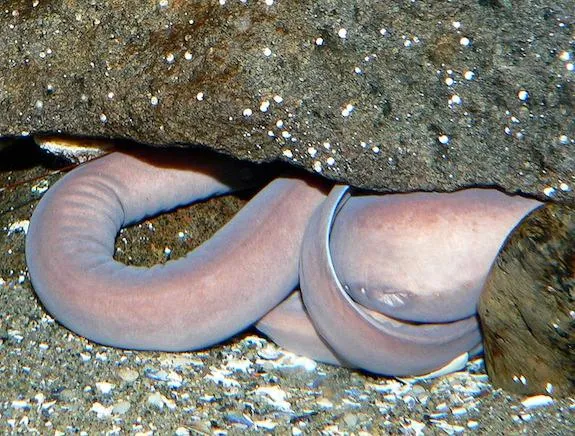14 Fun Facts About Hagfish
These frightening creatures defend themselves with slime and chow down on animal carcasses
/https://tf-cmsv2-smithsonianmag-media.s3.amazonaws.com/filer/6e/b3/6eb39914-a950-40f7-80ab-a547ca735487/cc5bc2.jpg)
Hagfish are widely considered the most disgusting animals in the ocean, if not on earth. The eel-shaped creatures use four pairs of thin sensory tentacles surrounding their mouths to find food—including carcasses of much larger animals. Once they find their meal, they bury into it face-first to bore a tunnel deep into its flesh.
Despite the fact that they seem repulsive, they are undoubtedly unique—and just because animals are disgusting to human sensibilities doesn’t mean they don’t deserve our attention and protection. That is the message behind Hagfish Day, which occurs every year on the third Wednesday of October: that we can find beauty in the ugly and protect all ocean animals. Here are 14 fun facts about the unusual group of animals:
1. The estimated 76 species of hagfishes live in cold waters around the world, from shallow to as deep as 5,500 feet (nearly 1,700 meters).
2. Hagfish can go months without food.
3. Hagfish can absorb nutrients straight through their skin.
4. They are sometimes called “slime eels”—but they are not eels. They are in the class Agnatha, designated for fish without jaws (around 100 species in total).

5. Although they are jawless, hagfish have two rows of tooth-like structures made of keratin that they use to burrow deep into carcasses. They can also bite off chunks of food. While eating carrion or live prey, they tie their tails into knots to generate torque and increase the force of their bites.
6. A 2011 report from the International Union for Conservation of Nature (IUCN) found that 12% of hagfish species are at an elevated risk of extinction. One hagfish species is critically endangered, two are endangered, six are vulnerable to extinction and two are near-threatened.
7. No one is sure whether hagfish belong to their own group of animals, filling the gap between invertebrates and vertebrates, or if they are more closely related to vertebrates.
8. The only known fossil hagfish, from 300 million years ago, looks very much like a modern hagfish, leading some scientists to speculate that it has changed little since then. “It’s an indication, not that they’ve stalemated and are not evolving, but that they have arrived at a body plan that is still very successful today,” says Tom Munroe, a fish zoologist at the Smithsonian National Museum of Natural History.
9. To ward off predators and other fish trying to steal their meals, hagfish produce slime. When harassed, glands lining their bodies secrete stringy proteins that, upon contact with seawater, expand into the transparent, sticky substance. According to common hagfish mythology, they can fill a 5-gallon bucket with the stuff in mere minutes.
10. This slime gives hagfish a slippery exit when attacked by predators. A larger fish looking for a meal instead gets a mouth full of slime, while the hagfish can slide away.
11. To prevent choking on its own slime, a hagfish can “sneeze” out its slime-filled nostril, and tie its body into a knot to keep the slime from dripping onto its face.
12. Although their eating habits seem disgusting, hagfish help clean and recycle dead animals from the seafloor. They also serve as a food source for fish, seabirds and seals—at least those that can make it through the slime.
13. Not only are hagfishes jawless, but they are also boneless. They have a skull made of cartilage, but no vertebrae.
14. Hagfish are threatened from both intentional fishing and unintentional bycatch. Hagfish weren’t always fished, but because several more preferable fish species are overfished and hard to catch, fishermen have moved down to catching hagfish.
Learn more about the ocean from the Smithsonian’s Ocean Portal.